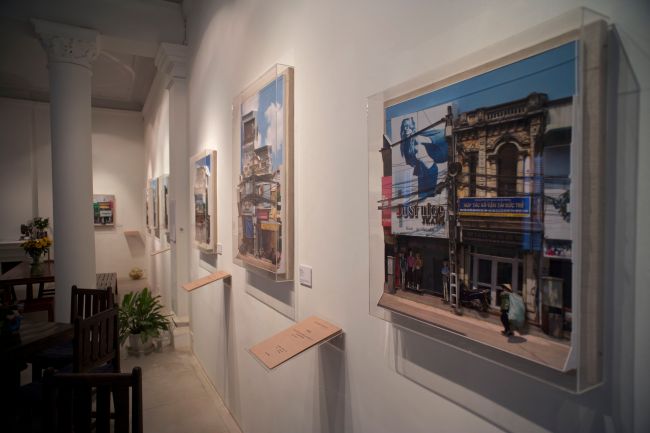Asian Art Happenings- 26 Dec 2013
Nguyen the Son on Vietnamese Contemporary Art
Nguyễn Thế Sơn is an important Vietnamese artist who has been critically observing the changes in his urban environment. His multidisciplinary art practices embraces silk painting, photography, photo relief and photo installation. In December 2013, Asian Art Happenings had a unique opportunity to discuss the concepts driving the creative processes behind his work.
Please can you tell us a bit about your background?
I graduated in 2000 from the Chinese Language department of the Foreign Language University, Hanoi, prior to studying at the Hanoi Fine Arts University. Post graduation from the Fine Arts University 2002, I worked there as a lecturer until 2008. Subsequently, I enrolled at the Central Academy of Fine Arts (CAFA), Beijing, China. Whereupon I completed a Master’s degree in Fine Arts, majoring in photography, and was taught by leading Chinese multimedia artist/lectures such as Miao Xiaochun. On graduation in 2012 I returned to Hanoi to join the Fine Arts University, Vietnam as a lecturer.
Can you describe the styles and techniques that you were taught?
I was taught silk painting and lacquer painting in Fine Art faculty. These techniques belong to the traditional Vietnamese art schools.
When did you hold your first exhibition?
My first exhibition was in 2004 with a photo-installation project Story of Water at Vietnam Fine Art University.
When was your most recent exhibition?
My recent solo exhibition was in October 2013 at Manzi Art space in Hanoi with “Nhà Tây” Transforms project. My current is “Karaore series” (Nha mat Pho) in Seoul, and VINATREE photo-installation in I-CAMP project in MUONG Museum, Hanoi.
Please can you tell us about the composition of your work and the process by which your art is created.
Actually the composition of my art works is quite flexible, with each style pertaining to the concept underpinning the relevant project. Sometime I use a silk painting technique combined with objects. For example, the colourful pin and rough silk in Super Conductor (2008) and New Higher Level (2010) series. Sometimes I integrate photography, installation and social research in works like VINATREE (2007) or Leaf Shadow (2005) as well as in my photo-installations.
Most recently I have meshed the design techniques, materials and works produced by local advertising companies with architectural photography and social research, interviews and personal investigation to create a new concept of Photorelief, which resulted in the Nha Mat Pho project and Nha Tay Transforms project. On other occasions, I use video-installation.
Can you expand upon thoughts regarding the influence of mass consumerism on Vietnam, and in particular Hanoi?
Yes, actually my art practice methodology focuses on social/ historical phenomena and traces the changing visual imagery in Vietnamese society. And the mass consumerism in Vietnam is only one part of the influence of “The power and alienation”.
Do you ever encounter creative blocks or points where you struggle to find inspiration and what would you say is your greatest source of inspiration for your work?
Across Southeast Asia societies are changing at a rapid pace. In Vietnam, society is transforming so fast we can think about the city as a loci of conflict, particularly in Hanoi where indigenous socio-economic and political values are being impacted by globalisation and the mass media. The turbulence that can be caused by urbanisation and changing demographics is especially visible in the capital, Hanoi where my art practice is based. In Hanoi, all the best and worst aspects of change are concentrated, and it is in this rapidly changing environment that I can observe how visual signals and symbols are changing very fast, and the conflicts that these changes are causing in the lives of the Vietnamese. It is against the backdrop of this change that I can find the greatest inspiration for my artistic practice.
Are there any artistic processes that you are keen to try that you have not attempted yet?
Yes, I intend to make all my photo relief art works in “ Nha Mat Pho” series as a real sculpture in a totally white colour using the laser cutting technique ( see my new project Empty City https://nguyentheson.com. However, this project is quite expensive as I will have to solve some problems in the creation of a 3D effect.
What has been the most challenging series of artwork and why?
I think my most challenging series recently involved the use of photo relief techniques (Nha Mat Pho and Nha Tay Transform series), where I try to combine local advertising techniques with photography and my social semiotic research.
How do you see contemporary painting evolving in Vietnam?
I think the problem in contemporary painting in Vietnam is that on the whole, artists only focus on the outside of art work. That is to say, they want to make their works “look like” contemporary art works, which is why we can see that a lot of artists’ paintings are similar to Chinese contemporary painting. It’s the truth. And I think the most important problem is almost artists in Vietnam are very afraid art theory in general. They do not really understand the thought process required to produce a contemporary art work. And a lot of artists even don’t know anything about post-modern or deconstructivism concepts. Therefore, their concepts are not strong enough to produce new forms and works.
https://nguyentheson.com/about-son/ For details on solo and group exhibitions.
Additional works by this artist
Nhà Tây Transforms










